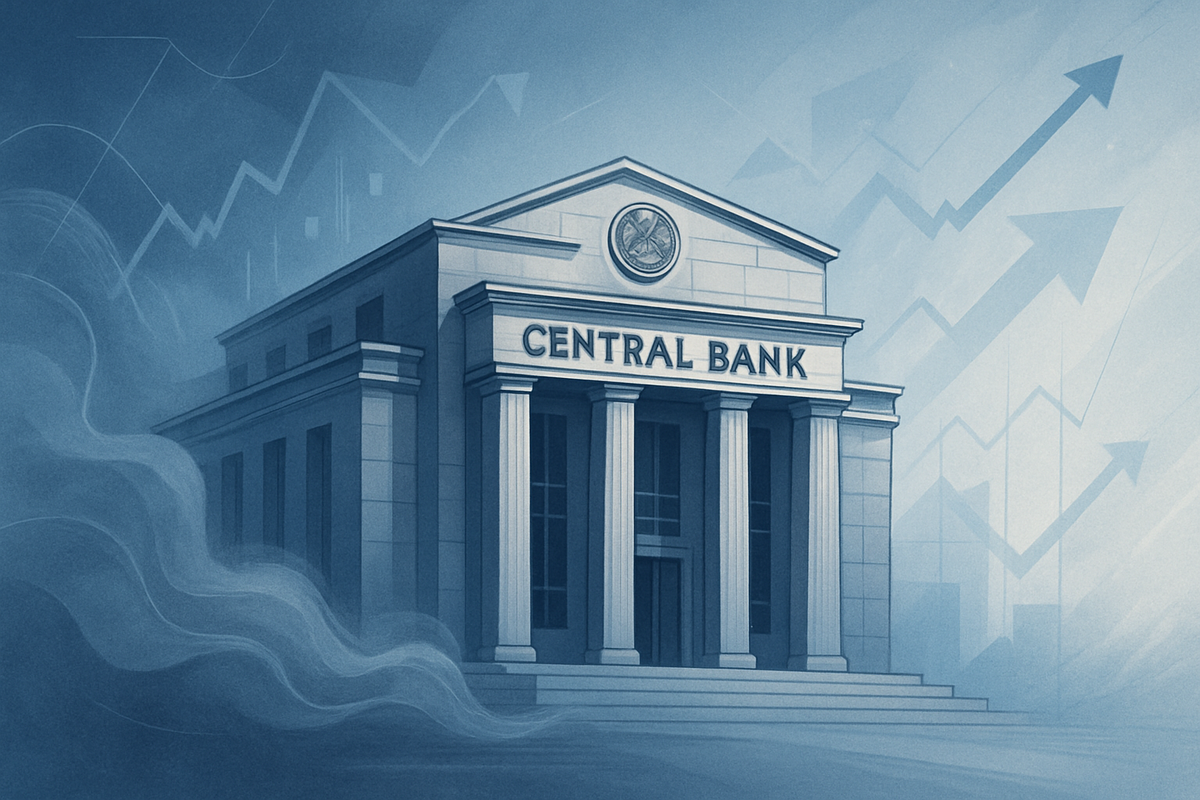
Amsterdam, Netherlands – October 3, 2025 – Federal Reserve Bank of New York President John Williams delivered a pivotal address today, emphasizing the urgent need for central banks worldwide to cultivate a mindset of preparedness for unforeseen economic shifts. Speaking at the Klaas Knot Farewell Symposium, Williams's remarks, titled "Prepare for the Unexpected," underscored that "unpredictable change and uncertainty will certainly continue to be with us for the foreseeable future," driven by forces ranging from global demographic shifts to the transformative power of artificial intelligence and innovations within financial systems. While not directly detailing immediate interest rate moves, his philosophical stance suggests a future where monetary policy will prioritize flexibility and responsiveness to a rapidly evolving global economic landscape, potentially shaping how the Federal Reserve (FED) (US:FED) navigates upcoming challenges.
Williams's call to action signals a growing recognition within top financial institutions that traditional economic models and policy frameworks may be insufficient to tackle the complexities of the modern era. This proactive approach could lead to more adaptive monetary policy decisions, where the Fed and other central banks are ready to deploy a broader toolkit, including instruments once considered unconventional, to maintain economic stability and price consistency. Investors and markets are now keenly watching how this philosophy translates into concrete strategies, particularly concerning interest rate adjustments and liquidity management, in an environment still grappling with post-pandemic aftershocks and emerging technological disruptions.
A New Era of Central Banking: Embracing Uncertainty as a Core Principle
President Williams's October 3, 2025, address in Amsterdam served as a profound philosophical declaration, urging central bankers to embed "prepare for the unexpected" as a core tenet of their operational framework. He highlighted that the global economy is in a perpetual state of flux, necessitating robust principles and strategies to manage a wide array of contingencies, including those that are entirely novel. A cornerstone of his argument was the critical importance of anchoring inflation expectations, a task he asserted "cannot be taken for granted" amidst such uncertainty. Furthermore, Williams acknowledged that tools like bond buying, once viewed as extraordinary, have now become a normal and accepted part of the central bank's arsenal, indicating a permanent expansion of policy options.
This latest pronouncement from Williams is not an isolated event but rather the culmination of a year-long evolution in his public statements regarding monetary policy. As early as April 2025, Williams had projected a significant slowdown in real GDP growth, an uptick in unemployment, and elevated inflation, partly due to increased tariffs, prompting the Federal Open Market Committee (FOMC) (US:FOMC) to hold the federal funds rate steady at 4.25% to 4.5% to manage heightened economic uncertainty. By August 2025, a shift in sentiment began to emerge, with Williams hinting that a rate cut could be appropriate as soon as September, noting that the Fed was still in a "modestly restrictive stance" and believing that as inflation continued its descent towards the 2% target, it would be fitting to "move interest rates down over time."
Indeed, the Federal Reserve acted on this evolving perspective. In September 2025, the central bank initiated a gradual lowering of short-term borrowing costs, bringing the federal funds rate down to a range of 4%-4.25%. Williams characterized this existing monetary policy stance as "modestly restrictive" and "appropriate" for current economic conditions, downplaying the impact of tariffs on inflation and suggesting that with lessened inflation risks and increased employment risks, lowering interest rates made strategic sense. His October 3rd remarks, therefore, reinforce this agile approach, advocating for a policy framework that is not only reactive but also anticipatory, capable of adapting to a future defined by constant, unpredictable change.
Corporate Fortunes: Navigating a Flexible Monetary Landscape
The Federal Reserve's evolving philosophy, championed by President John Williams, towards an agile and preparedness-focused monetary policy, is poised to create distinct winners and losers across various sectors. Companies with strong balance sheets, low debt, and diversified revenue streams are likely to be more resilient and potentially thrive in an environment characterized by unpredictable shifts in interest rates and economic conditions. Conversely, highly leveraged companies, those sensitive to interest rate fluctuations, or businesses heavily reliant on stable, predictable economic growth may face significant headwinds.
Potential Winners:
- Technology & Innovation (e.g., Apple (NASDAQ: AAPL), Microsoft (NASDAQ: MSFT)): Companies at the forefront of AI and other transformative technologies, as mentioned by Williams, stand to benefit from the long-term trends driving economic change. Their ability to innovate and adapt quickly positions them well in an uncertain environment, potentially attracting continued investment even if interest rates fluctuate. Moreover, a flexible Fed might be quicker to ease policy if technological advancements lead to disinflationary pressures.
- Financial Services (e.g., JP Morgan Chase (NYSE: JPM), Goldman Sachs (NYSE: GS)): While interest rate volatility can create challenges, large, diversified financial institutions with sophisticated risk management capabilities can capitalize on increased market activity, hedging needs, and the demand for advisory services during periods of economic re-calibration. Their ability to navigate complex financial landscapes and offer tailored solutions to corporations and individuals will be crucial.
- Consumer Staples (e.g., Procter & Gamble (NYSE: PG), Coca-Cola (NYSE: KO)): These companies tend to be more defensive in uncertain economic times. Their consistent demand for essential goods makes them relatively stable investments, often outperforming during periods of market volatility or economic slowdowns that might prompt the Fed to adjust policy.
Potential Losers:
- Highly Leveraged Companies (e.g., certain Real Estate Investment Trusts (REITs), highly indebted industrial firms): Businesses with substantial debt burdens are particularly vulnerable to interest rate changes. Even gradual rate increases, or the uncertainty surrounding future rate paths, can significantly increase their borrowing costs, impacting profitability and growth prospects. Conversely, while rate cuts might offer some relief, the underlying uncertainty that prompts such cuts could still weigh on their operational environment.
- Growth Stocks with High Valuations (e.g., smaller, unprofitable tech firms): In an environment where the cost of capital can shift, investors may become more discerning. Companies relying heavily on future growth projections and external funding might find it harder to secure capital or maintain their valuations if economic uncertainty or higher-for-longer rate scenarios materialize.
- Cyclical Industries (e.g., Automotive, Airlines, Luxury Goods): These sectors are highly sensitive to economic cycles and consumer discretionary spending. If Williams's "prepare for the unexpected" philosophy leads to more frequent or significant policy adjustments in response to economic downturns, these companies could experience greater volatility in demand and earnings.
The key for companies across all sectors will be their agility and foresight in adapting to a monetary policy regime that prioritizes flexibility and resilience. Those that can manage their debt, innovate effectively, and maintain strong operational efficiencies will be best positioned to weather the storms of an unpredictable future.
Broader Implications: Reshaping Global Economic Governance
John Williams's emphasis on preparing for the unexpected extends beyond mere tactical adjustments to monetary policy; it represents a significant philosophical pivot that could reshape global economic governance and how central banks interact with the broader financial ecosystem. This approach signals a move away from rigid, forecast-dependent frameworks towards a more dynamic, scenario-based planning model, acknowledging the inherent limitations of predicting complex economic phenomena. This aligns with broader industry trends where resilience and adaptability are increasingly valued in the face of geopolitical instability, supply chain disruptions, and rapid technological advancement.
The potential ripple effects of such a philosophy are considerable. For competitors and partners of the Federal Reserve, including other major central banks like the European Central Bank (ECB) (EU:ECB) and the Bank of Japan (BOJ) (JP:BOJ), Williams's stance could encourage a similar re-evaluation of their own preparedness strategies. A coordinated global effort towards greater flexibility could lead to more robust international financial stability, but divergent approaches might exacerbate global economic fragmentation. Regulatory bodies might also be influenced, potentially pushing for more stringent stress testing and capital requirements for financial institutions to ensure they too are prepared for a wider range of "unexpected" scenarios.
Historically, central banks have often been criticized for being reactive rather than proactive, with policy adjustments typically following economic downturns or inflationary spikes. Williams's call for preparedness echoes lessons learned from past crises, such as the 2008 financial crisis and the COVID-19 pandemic, where policymakers were forced to innovate rapidly under extreme pressure. The embrace of "unconventional" tools as "normal" reflects this learning, suggesting that the era of relying solely on interest rate adjustments is long past. This move towards a more comprehensive toolkit and a mindset of continuous readiness is a direct response to the increasing frequency and severity of black swan events in the 21st century. The implications are profound, suggesting a future where central banks are not just economic managers, but also strategic risk architects, constantly scanning the horizon for potential threats and opportunities.
The Path Ahead: Navigating an Era of Constant Vigilance
The Federal Reserve Bank of New York President John Williams's recent remarks herald an era where central banks, particularly the Federal Reserve, will operate with heightened vigilance and an ingrained philosophy of preparing for the unexpected. In the short term, this mindset suggests that monetary policy decisions, including future interest rate adjustments, will be characterized by a greater degree of agility and data-dependency. The Fed is likely to remain responsive to incoming economic data, prepared to pivot its stance swiftly in response to unforeseen inflationary pressures, employment shocks, or financial instability. This could translate into more frequent, albeit potentially smaller, adjustments to the federal funds rate, moving away from prolonged periods of static policy.
In the long term, this philosophy demands strategic pivots and adaptations across the entire financial ecosystem. Central banks may invest more heavily in advanced analytical tools and scenario planning to model a broader spectrum of potential economic futures. For markets, this means a potential increase in volatility as policy reactions become less predictable, offering both challenges and opportunities. Investors may need to adopt more dynamic portfolio strategies, favoring assets that demonstrate resilience across diverse economic conditions. Companies, in turn, will be compelled to build stronger balance sheets and more adaptable business models to withstand rapid shifts in the economic environment. The emergence of new market opportunities could arise in sectors providing solutions for risk management, economic forecasting, and adaptive technologies.
Potential scenarios range from a "smooth sailing" outcome, where the Fed's preparedness successfully mitigates major shocks, leading to sustained but modest growth, to a "turbulent waters" scenario, where frequent unexpected events necessitate constant policy interventions, leading to increased market uncertainty. Another possibility is a "technological leap" scenario, where rapid advancements, particularly in AI, fundamentally alter economic structures, requiring the Fed to innovate its policy tools to address entirely new challenges like tech-driven disinflation or new forms of financial risk. The overarching outcome will depend on the interplay between the severity of future unexpected events and the effectiveness of the Fed's proactive, agile policy response.
Conclusion: A New Paradigm for Monetary Stability
John Williams's call for central banks to "prepare for the unexpected" marks a significant turning point in the philosophy guiding monetary policy, emphasizing adaptability and foresight in an increasingly unpredictable global economy. The key takeaway from his October 3, 2025, remarks is a recognition that the economic landscape is perpetually evolving, driven by profound shifts like demographic changes, the rise of artificial intelligence, and financial innovation. This necessitates a proactive, flexible approach to central banking, where the Federal Reserve and its global counterparts are equipped with a broader toolkit and a mindset of continuous readiness. The Fed's actions earlier in 2025, including the September rate cut, already reflect a move towards a more agile policy stance, acknowledging receding inflation risks and the need for a "modestly restrictive" but responsive framework.
Moving forward, the market should anticipate a monetary policy environment characterized by increased vigilance and a willingness to adjust course swiftly. This means investors should prepare for potentially more frequent, data-driven policy shifts, which could introduce periods of heightened market volatility. Companies that are financially robust, adaptable, and innovative are best positioned to thrive, while those with high leverage or rigid business models may face greater challenges. The wider significance lies in the potential for a global paradigm shift in central banking, fostering greater resilience but also demanding a new level of sophistication from market participants.
Investors in the coming months should closely watch for further communications from Federal Reserve officials regarding their interpretation of "unexpected" events and how these might influence future interest rate decisions. Pay attention to economic indicators, particularly those related to inflation and employment, as these will continue to guide the Fed's agile response. Furthermore, monitor technological advancements and geopolitical developments, as these are the very "unexpected" forces Williams highlighted. The era of constant vigilance is here, and understanding its implications will be paramount for navigating the financial markets successfully.
This content is intended for informational purposes only and is not financial advice






